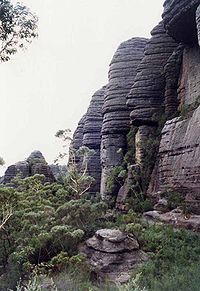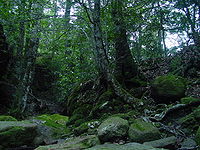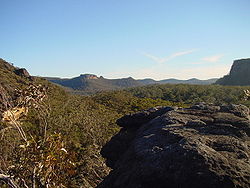
Budawang Range
Encyclopedia

Mountain range
A mountain range is a single, large mass consisting of a succession of mountains or narrowly spaced mountain ridges, with or without peaks, closely related in position, direction, formation, and age; a component part of a mountain system or of a mountain chain...
largely located within the Budawang National Park
Budawang National Park
Budawang is a national park in New South Wales, Australia, 200 km southwest of Sydney. It contains part of the Budawang Mountain Range....
and Morton National Park
Morton National Park
Morton is a national park in New South Wales , 170 km southwest of Sydney.The most notable attractions are the Fitzroy Falls, just off the main road from the Highlands to Kangaroo Valley and Pigeon House Mountain west of Milton. The park consists mostly of a flat plateau dissected by steep...
in New South Wales
New South Wales
New South Wales is a state of :Australia, located in the east of the country. It is bordered by Queensland, Victoria and South Australia to the north, south and west respectively. To the east, the state is bordered by the Tasman Sea, which forms part of the Pacific Ocean. New South Wales...
, Australia
Australia
Australia , officially the Commonwealth of Australia, is a country in the Southern Hemisphere comprising the mainland of the Australian continent, the island of Tasmania, and numerous smaller islands in the Indian and Pacific Oceans. It is the world's sixth-largest country by total area...
. The Budawangs have been declared a Wilderness Area. The Budawangs are very popular with bush walkers due to their impressive terrain and unique features. The Clyde River has its source in the Budawangs.
Areas of interest

- The Castle
- Mt Pigeon House
- Monolith Valley
- The Seven Gods Monoliths
- Mt Budawang
- Clyde River Valley
- Hidden Valley
- Mt Tarn
- Mt Cole
- Ettrema Gorge
Maps
If walking in the Budawangs a recommended resource is the Northern Budawang Range and the Upper Clyde River Valley sketch map, published by The Budawang Committee and available in most SydneySydney
Sydney is the most populous city in Australia and the state capital of New South Wales. Sydney is located on Australia's south-east coast of the Tasman Sea. As of June 2010, the greater metropolitan area had an approximate population of 4.6 million people...
/Nowra/Canberra
Canberra
Canberra is the capital city of Australia. With a population of over 345,000, it is Australia's largest inland city and the eighth-largest city overall. The city is located at the northern end of the Australian Capital Territory , south-west of Sydney, and north-east of Melbourne...
bushwalking stores. The sketch map was hand drawn and details many of the possible walks in the most popular part of the national park. The area is also covered by the 1:25,000 CMA maps CORANG (8927-3-N), ENDRICK (8927-4-S), TIANJARA (8927-1-S) and MILTON (8927-2-N).
Aboriginal use


There are archaeological records of Aboriginal presence in the area dating back to around 11,000 years ago. Nearby coastal deposits have been dated at around 20,000 years old, so occupation in the Budawangs may well be older than current evidence suggests. Archaeological evidence found in the area includes occupational deposits in rock shelters, open campsites, and axe grinding grooves often found on rocks by the sides of creeks in the area. Art sites and rock arrangements also exist in the Budawangs though they are quite rare - the best of these is on Quilty's Mountain.
Grazing and farming
There are several grazing farmlands surrounding the National Parks region both in the East and the West.Logging
Logging began in the Budawang area in the early 1900s, it continues to this day in areas that remain outside of the National Parks such as Yadboro State Forest.Military use
The army operated an artillery range on the Tianjara plateau between 1943 and 1974, also using the area for practice bombing and exercises often involving offroad vehicles. This area is highly damaged and littered with target debris and unexploded ordnance. Extreme care should be undertaken if walking in or near this area.Navy jet aircraft and helicopters use the area as a designated low-fly training area, allowing high speed flight through the area at 50 feet above the ground.
Getting there
Since the Budawangs are only accessible from gravel roads, care should be taken after rain as the roads can become slippery.The northern parts of the area including the Clyde River valley are best accessed from the Braidwood
Braidwood, New South Wales
Braidwood is a town in the Southern Tablelands of New South Wales, Australia, in Palerang Shire. It is located on the busy Kings Highway linking Canberra to Batemans Bay on the coast. It is about 200 kilometres south west of Sydney and about 60 kilometres inland from the coast...
Nowra road. There are two entrances in the northern part of the park. One is near Nerriga and requires walking through farmland to the area around Quilty's Mountain. The other (main) northern entrance is a not very clearly marked gate on the side of the road near Sassafras.
Access to The Castle and Monolith Valley is best achieved from Long Gully just off the Western Distributor.
Access to the western 'Wog Wog' side of the park is via a park entrance off the Mongarlowe/Nerriga road, either coming from Braidwood to the south or Nowra to the north.
All three main entrances now have marked campsites and pit toilets. The Sassafrass campsite is approx. 200m down the fire trail from the carpark and has tank water and a sheltered picnic table. The Wog Wog campsite has no water, so don't forget to bring your own. The Long Gully campsite has the Yadboro creek for water.


